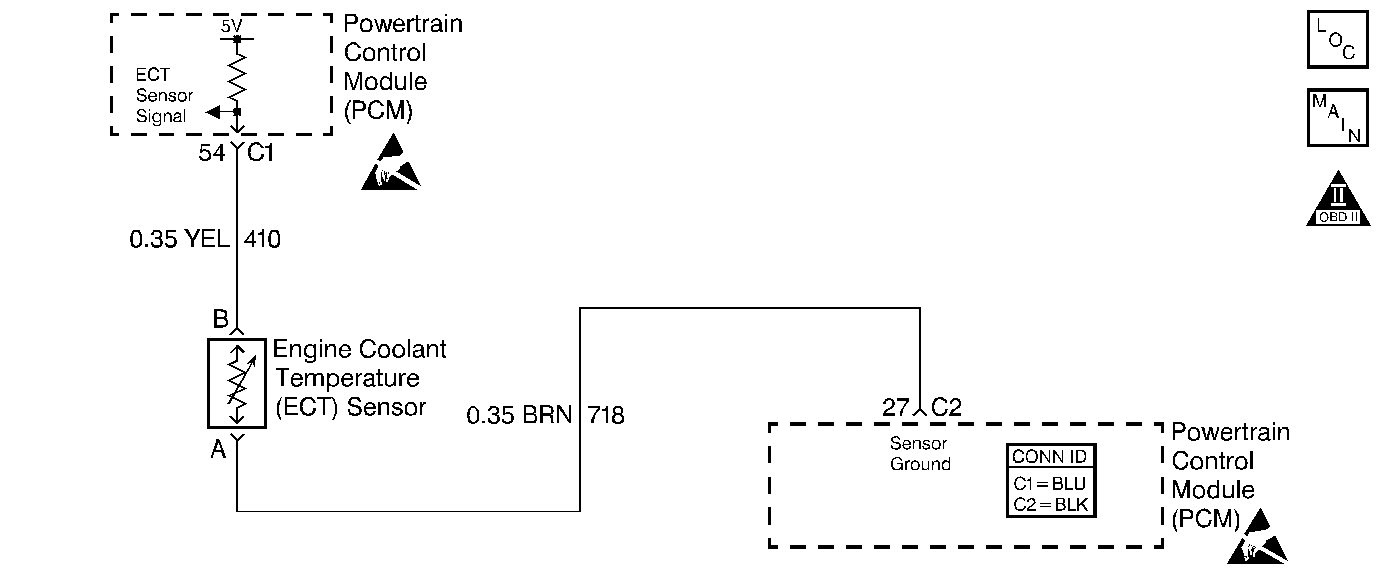
Circuit Description
The Engine Coolant Temperature (ECT) sensor uses a thermistor in order to control the signal voltage to the Powertrain Control Module (PCM). The PCM supplies a voltage on the signal circuit to the sensor. When the engine is cold, the sensor resistance is high, therefore, the ECT signal voltage will be high.
As the engine warms, the sensor resistance becomes less and the voltage drops. At the normal engine operating temperature, the voltage will be between 1.5 and 2.0 volts at the ECT signal terminal.
The ECT sensor controls the following items:
| • | The fuel delivery |
| • | The Torque Converter Clutch (TCC) |
| • | The Ignition Control (IC) |
| • | The Evaporative Emission (EVAP) canister purge valve |
| • | The Idle Air Control (IAC) valve |
| • | The Electric cooling fan |
Conditions For Running The DTC
The engine run time is greater than 128 seconds.
Conditions for Setting the DTC
The ECT sensor indicates that the engine coolant temperature is more than 138°C (280°F) for 12.5 seconds.
Action Taken When the DTC Sets
| • | The Malfunction Indicator Lamp (MIL) will illuminate. after two consecutive ignition cycles in which the diagnostic runs with the fault active. |
| • | The PCM will record the operating conditions at the time that the diagnostic fails. This information will store in the Freeze Frame and Failure Records buffers. |
| • | A history DTC stores. |
| • | The coolant fan turns ON. |
| • | The PCM will default to 20°C (68°F) for the first 60 seconds of the engine run time and then to 92°C (198°F). |
Conditions for Clearing the MIL/DTC
| • | The MIL will turn OFF after three consecutive ignition cycles in which the diagnostic runs without a fault. |
| • | A history DTC will clear after 40 consecutive warm up cycles without a fault. |
| • | Use a scan tool to clear the DTCs. |
Diagnostic Aids
| • | The normal operation temperature of the cooling system is between 90°C (194°F) and 95°C (203°F). |
| • | Intermittent P0117 is caused by a poor electrical terminal connection. |
| • | Use the Temperature vs. Resistance table in order to evaluate the possibility of a skewed sensor. Refer to Temperature Versus Resistance . |
Test Description
The numbers below refer to the step numbers on the diagnostic table.
-
This step simulates a DTC P0118. The PCM and the ECT wiring are OK if the PCM senses the change in the ECT sensor signal.
-
Reprogram the replacement PCM and perform the Crankshaft Position System Variation Learn procedure.
Step | Action | Value(s) | Yes | No |
|---|---|---|---|---|
1 | Did you perform the Powertrain On Board Diagnostic (OBD) System Check? | -- | ||
2 |
Does the ECT sensor value measure greater than the specified value? | 130°C (266°F) | ||
3 |
Does the ECT sensor value measure greater than the specified value? | 130°C (266°F) | Go to Diagnostic Aids | |
Does the ECT sensor value measure less than the specified value? | -30°C (-22°F) | |||
5 |
Did you find and correct the condition? | -- | ||
6 |
Did you complete the replacement? | -- | -- | |
Important:: The replacement PCM must be programmed and the Crankshaft Position Variation procedure must be performed. Did you complete the replacement? | -- | -- | ||
8 |
Does the DTC reset? | -- | System OK |
